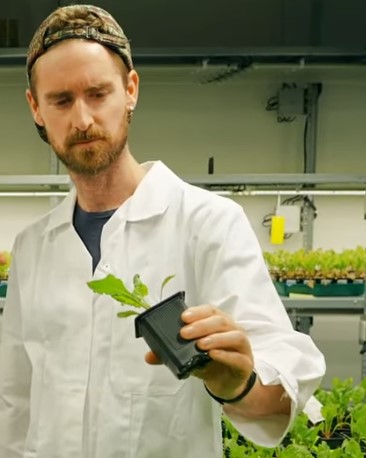Today’s guest author is Dr. David Spencer, a “plant tamer” by trade. David completed his doctorate in plant breeding at RWTH University and explains in an easy way what motivated him to work on the genetic optimization of crops and how he approached it. A doctoral thesis is usually not quite as simple as described here – there are setbacks and many experiments don’t work out right away the way you want them to. So it is very nice when, at the end of the day, at least in the model plant tobacco, the desired results are achieved! It is still a long way from field trials and their evaluation to the final approval of the plants – but the most important scientific step, the “proof of principle” has been taken!
We link his doctoral thesis here. It is rather difficult to read for laypeople, it is just to show how much work is behind this short article.
Here is David’s story:
Since the Neolithic Revolution, humans have been growing plants to feed the world’s population. In this breeding process, our vegetables have unlearned how to defend themselves against stressors like drought or pathogens. What if we can give them back these abilities?
The dilemma of agriculture
On the way to more sustainable agriculture, we are at a crossroads: we want to reduce the use of pesticides – but also harvest good, healthy vegetables. We want to preserve valuable habitats – but also feed a growing population. We want to eliminate the proven negative effects of land use on the environment, minimize its ecological footprint and grow climate-resistant varieties – but please, without mineral fertilizers, without pesticides, without long transport routes and without genetic engineering.Yet the latter in particular has great potential. Plant genetic engineering methods can be used to breed crops that really fit in well with our sustainability goals. The breeding history of plants can be roughly compared to that of our pets: sheepdogs are imposing, French bulldogs are sweet, greyhounds are fast. But they all tend to develop certain diseases – from hip problems to immune deficiencies. While we now have big, plump tomatoes after more than 10,000 years of plant breeding, they are, at the same time, more susceptible to pathogens of all kinds. The wild relatives of our crops (and livestock!) are much hardier, more resistant, and that’s where modern plant biotechnology comes in.Soybean rust
In my doctoral thesis, I investigated whether disease resistance can be generated in soybeans using genetic engineering methods. More specifically, the aim was to control “Asian soybean rust”, which is caused by fungi of the genus Phakopsora. This pathogen is responsible for considerable crop losses in South America, the USA and China and can currently only be kept in check with repeated applications of fungicides. A soybean variety that is immune to soybean rust does not exist on the market.
But there is reason for hope: In my research group at RWTH Aachen University, we are systematically searching for naturally occurring resistances in various plant families, identifying the genes responsible for them and transferring them to soybean. This allows us to assess the extent to which an exchange of these “plant superpowers” can work by means of gene transfer and what potential risks and opportunities are involved. Under laboratory conditions, we test so-called gene constructs by transferring them from one plant to another with the help of Agrobacterium tumefaciens (explained in more detail in the blog article on the American chestnut). This small bacterium manages to introduce DNA fragments produced by polymerase chain reaction (PCR) into the target organism via a vector. Successfully modified plants are then studied in more detail for side effects, yield and disease resistance.
Sunflowers
I got a first clue in the search for natural resistances during a visit to the botanical garden in Bonn, Germany. When evaluating more than 60 leaf samples of different species, it turned out that one plant is particularly resistant to fungal diseases: the sunflower. In the laboratory, I placed fungal spores of Phakopsora, the soybean pathogen, on sunflower leaves at different stages. The spores, which are otherwise very eager to germinate, showed no activity. At the same time, I was able to demonstrate that contact of sunflowers with the pathogen of soybean rust leads to a specific immune response of the plant: Genes of the so-called phenylpropanoid metabolism are activated and defense substances are transported to the leaf surface. The sunflower thus has the ability to recognize the foreign pathogen, rapidly produce effective defense substances and thus inhibit the fungal spores in their growth.

Fig.: Screenshot from YouTube video https://www.youtube.com/watch?v=cvC8OSuejmE )
Tobacco
As so often in science, follow-up questions were quickly found: How does the sunflower detect the presence of the fungus? How exactly does the transport of the defense substances to the leaf surface work? And which defense substances are involved at all? To find out, I rinsed the surface of the sunflower leaves with water and collected the “wash water” for further analysis. Using liquid chromatography, I found that two molecules from the coumarin family were particularly strongly represented in resistant varieties. In addition, together with our partners at the University Hospital in Aachen, we identified several antimicrobial proteins that were enriched in the sunflower wash water. In a first step, with the help of Agrobacterium, I introduced the necessary genes for production and transport of coumarins into a tobacco cell culture. Compared to the control cells without sunflower genes, the test cultures showed a significantly increased coumarin concentration in the culture medium.
Coumarins are known to be produced as a natural defense against fungal infections in various plants.
But the results of a cell culture experiment should be taken with a grain of salt: What works in single cells does not necessarily hold up in whole plants or in field trials. For this reason, I also grew adult tobacco plants in parallel with the cell cultures and tested the candidate genes from sunflower as well in a “transient transformation experiment.” In transient transformation, the agrobacterial solution is carefully forced into the tobacco plant through the stomata on the underside of the leaf using a syringe (“agroinfiltration”). By means of fluorescence and/or molecular markers, it can be checked a few days later whether the genes have been successfully transferred. Finally, analogous to the experiments with sunflowers, I collected the wash water from the tobacco leaves treated in this way and was able to document two observations: First, the coumarin content on the leaf surface was significantly increased by the transformation, and second, the wash water showed a clear germination-inhibiting effect on Phakopsora spores. The growth of the pathogen compared to the untreated control was reduced by about 50%.
Why tobacco? Is the cigarette industry behind this, so that tobacco can be planted even more effectively?
No, tobacco is a popular model plant for plant genetic engineering. The plants are easy to grow, the genome is known, and the large leaves are very suitable for “agroinfiltration”, the local genetic modification in a leaf.
And what about the soybeans?
In summary, then, I have been able to show that the ability for an immune response can be transferred from one plant species to another – and that this can be done by selectively introducing the necessary genetic information using genetic engineering. The evaluation of the field trials in soybean is being carried out by a cooperation partner in Brazil and is currently still pending. If my findings from the tobacco trials are also confirmed for soybean, the next step would be registration and approval of a new variety. My work is just one of many examples of how nature can provide us with valuable tools that we can use with modern molecular methods. From natural alternatives for crop protection using sunflowers to substituting meat with legumes to bio-based rubber tires from dandelion plant sap, the list of applications is almost endless.
Despite these hopeful prospects, all research is for nothing if it meets with rejection in politics and society. In the case of green genetic engineering, we are looking at a very special, almost traditional form of rejection, which is fed by misinformation and a strong anti-GM lobby, especially in Germany and the EU. As a scientist, I am convinced that genetic engineering legislation is outdated and urgently needs to be adapted to the state of research so that we can use it for truly sustainable food production. During my doctorate, I have therefore already tried out many science communication formats in an attempt to make the complex topic of genetic engineering more tangible. In addition to numerous science slams, a plant podcast sponsored by the German Federal Ministry of Education and Research, and invitations to panel discussions, specialist congresses and school events, a popular science non-fiction book entitled “Alles bio – logisch?!” was published in April 2022. As an author and freelance publicist, I continue to be active in evidence-based sustainability after completing my PhD.

David produces his podcast and Youtube contributions himself to make the topics of plant research more tangible. Photo: BIOCOM
Recommended Links by David:

